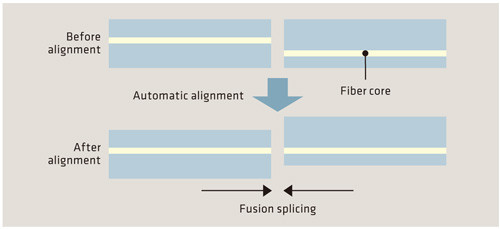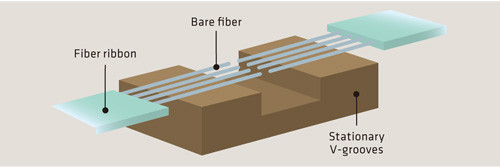In previous articles, we've covered tips for first-time users, splicing tips, and the importance of electrode replacement. It is inevitable that there is loss in the splicing fiber, so is it true that the more expensive the fusion splicer is, the lower the loss of splicing will be? Today, with problems, let's discuss the real causes of the loss of splicing.
The relative cores of incoming optical fibers must be properly aligned.
The following situations are the real causes of splice loss.
Classification and principles of splicing
Optical fiber splicing machine splicing is the use of the electrode generated by the arc between the hot optical fiber joint. splicing is divided into two methods, as described below.
First:Core alignment method (core alignment) with the help of image processing by observing the positioning of fiber cores with a microscope, make them align with the same center. The arc is then applied to the fiber core. The use of fiber melting machine with a camera in two directions of observation and positioning.

Second:Fixed v-groove alignment method (cladding alignment)
This splicing method USES v-shaped slots generated by high-precision positioning and orientation of optical fibers, and USES the alignment effect to fuse the surface tension of optical fibers (cladding alignment). Joints manufactured in this way achieve low loss due to recent optical fiber production processes, which have improved dimensional accuracy with regard to the position of the cores. This method is mainly used to splice multiple fiber optic cables in a single action.

Causes of mechanical connection loss:
First:Poor concentricity
Poor concentricity of added fiber leads to connector/fuse loss. In a single-mode fiber, the connector/connector loss value is generally calculated as the square of the deviation times 0.2. For example, if the wavelength of the light source is 1310 nanometers, do not pass through the result of 1 micron at about 0.2 decibels loss.

Second:Axial runout
The occurrence of connector/connector losses due to axial run-out of optical fibers between the optical axes is coupled. For example, it is necessary to use the fiber cutting knife before welding, because such an Angle can lead to splicing with the jumping fiber, to avoid increasing the Angle at the fiber cutting end.

Third: Clearance
The gap between the optical fibers leads to connector/splice losses. For example, if the end face of an optical fiber is not mechanically spliced correctly, a joint loses its butt joint.

Four:Reflection
The fiber results between the end gaps at 0.6 db of maximum return loss due to the change in refractive index from the fiber to the air. Clean fiber ends are important for optical connectors. In addition, the entire optical connector end should be cleaned, as loss can also occur from dirt between the optical connector ends.
Copyright © 2021 Guangzhou Weyes Network Technology Co., Ltd. | All Rights Reserved